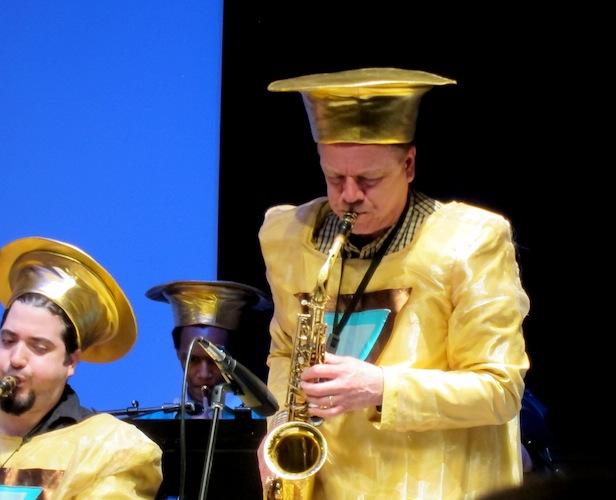Concert Review: Jazz Giant Sun Ra at 100 — Space Conquers Time
Ken Schaphorst and Boston’s Museum of Fine Arts made the case for Sun Ra as an Egyptologist (who claimed to be from Saturn).

Singer Nedelka Prescod and percussionist Jerry Leake of the Ken Schaphorst Big Band — she sung or scatted on almost all of the seven selections. Photo: Michele Brangwen.
by Milo Miles
The bandleader, jazz composer, and keyboardist Sun Ra posed a potent question, in both his life and work, that will never be answered: how seriously do you take him? As an artist, the answer is plain: very seriously indeed, he’s a master. Everything else about his philosophy and wisdom is more ambiguous. He would insist, for instance, that he had somehow been re-born on Saturn. But despite (or because of?) that mind-twisting, he remains a perpetually intriguing figure who should be treated thoughtfully.
On May 11, Ken Schaphorst, along with a 10-piece ensemble of New England Conservatory students and faculty (plus Grammy-nominated guest trumpeter Tim Hagans), offered a tribute called Sun Ra’s Centenary: Space Is Still the Most Colorful Place. The Centenary concert, a collaboration between NEC and the Museum of Fine Arts, was straightforward (Ra was born on May 22, 1914), but there were those pesky Ra ambiguities. Was Mother’s Day an appropriate date? (During the show, Schaphorst noted that, well, it was a SUNday, and a sunny Sunday at that.) Plus, the performance was at Remis Auditorium at the MFA, which houses the largest collection of Egyptian artifacts outside of Cairo. Given Sun Ra’s longstanding fascination with all things ancient Egyptian, it would be perverse not to try to build a bridge between the auditorium show and the museum showcases.
This seemingly daunting task was given to Lawrence Berman, Senior Curator of Ancient Egyptian, Nubian, and Near Easter Art at the MFA. Dr. Berman began exactly right by noting that there was always a showbiz element in Ra’s Egyptology. For example, when he showed up in Pharaoh costume for the 1974 documentary, Space Is the Place, the Egyptian regalia had been purchased from a costume shop and combined elements of both the emperor and empress crown in the headgear.
You can watch the whole documentary here:
Dr. Berman quickly added that Ra was not a dabbler or jiver — indeed, his concept that “space is the place” of freedom from earthly restrictions and prejudice is firmly rooted in Egyptian beliefs. The afterlife, in the sky, was exactly like life on earth, without the hassles. And there were many Egyptian spells intended to turn one into a bird who could ascend to that space which was the place, up there in the stars.
During lean times for Ra’s big band, which he called the Arkestra, members would simply appear and perform. But he always preferred colorful trappings. Ra’s idea of a big-band entertainment went all the way back to the Cotton Club revues and he saw no reason he shouldn’t put his stamp on doo-wop as well as free jazz, even as his show included dancers and, especially, singers. So it was entirely apt and gratifying that the Schaphorst ensemble included Nedelka Prescod singing and scatting on almost all of the seven selections. Less expected, but equally in order was that the 11 members of the band came out dressed in shiny yellow and blue robes, complete with huge padded shoulders and flat-topped tall hats in bright gold. topped off with a very regal, star-and-spangle dusted robe for leader Schaphorst.
(Such elaborate costumes seemed too much for a one-time performance, but Schaphorst was careful to thank the Opera Department of New England Conservatory for their help decorating this tribute to the Arkestra.)
A sure sign of the riches of Ra’s repertoire is that it can be sliced in so many different ways. This program consisted of space themes, naturally (“We Travel the Spaceways,” “Love in Outer Space”), catchy tunes (“Call for All Demons,” “Space Is the Place”) and what might be called Ra’s standards, numbers he reworked and performed many times over the years (“Enlightenment,” “Saturn”). A non-Ra magic ringer was “Egyptian Spell,” taken from the pyramid of King Unis (2354-2323 BC). Ra would certainly approve of the chantlike rhythms, Prescod’s charming rendition of the rise and fall of the Sun God’s boat-in-the-sky and Dr. Berman’s eerie, spoken transliteration of the Egyptian text (which might as well have been Saturnese).
The renditions from Schaphorst’s band avoided the cacophonous, everybody-solo-at-once passages the Arkestra sometimes favored, but one deep-seated quality of the group was evident: the all-for-one, nearly communal sense of unity. (Indeed, the costumes helped with that.) Even so, standout individual contributions included tart solos from special guest trumpeter Hagans, bad-boy-on-tenor rumbles from saxophonist Hery Paz and essential multi-rhythm interaction with drummer Robin Baytas and percussionist Jerry Leake and the proud throbs and bright arrangements from bassist Bob Nieske. Above all, the steady and unobtrusive direction (as well as careful dabs of keyboard and flugelhorn) from Schaphorst, who set the pace with an outlook that was seriously playful and playfully serious.
Milo Miles has reviewed world-music and American-roots music for “Fresh Air with Terry Gross” since 1989. He is a former music editor of The Boston Phoenix. Milo is a contributing writer for Rolling Stone magazine, and he also written about music for The Village Voice and The New York Times. His blog about pop culture and more is Miles To Go.
Tagged: Ken Schaphorst, Ken Schaphorst Big Band, Lawrence Berman, Milo Miles, museum-of-fine-arts-boston


